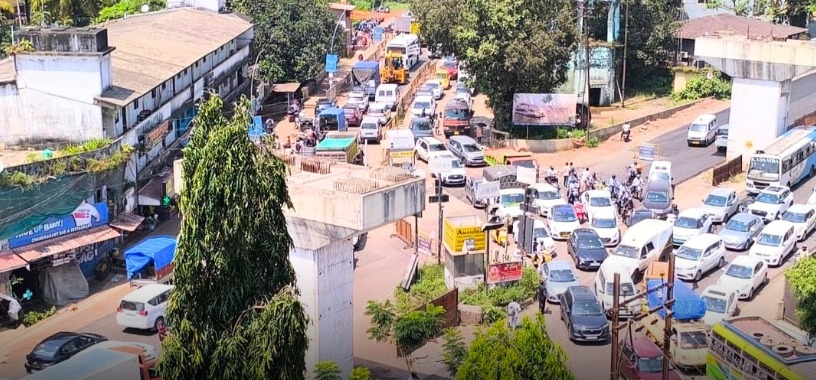There must be adequate public consultation, timely notification, and clear visual guidance through maps and signages at all entry points

The Monday morning trial run for traffic diversion along the Porvorim stretch of National Highway 66 between the O’Coqueiro Junction and the Socorro-Aradi Junction was intended to test the feasibility of partial road closures necessitated by the upcoming elevated corridor project. Instead, it tested the patience of hundreds of motorists. Within minutes of the closure taking effect, vehicles were seen inching forward in long queues beneath the scorching October sun. The gridlock extended through arterial side lanes and residential roads as commuters struggled to navigate unfamiliar detours.
For many, what should have been a fifteen-minute drive became an hour-long ordeal. School buses, ambulances, and two-wheelers were caught in the same bottleneck, with few visible indicators explaining alternative routes. The trial, intended as an administrative rehearsal, became a practical demonstration of what happens when execution precedes coordination. Yet, to be fair, the purpose of the trial was legitimate, testing traffic flow before a major infrastructural intervention, but the absence of timely information and guiding personnel transformed it into a public inconvenience.
It is in this backdrop that a continuing Public Interest Litigation PILWP No. 2656 of 2024 (F) before the High Court of Bombay at Goa assumes renewed relevance. The Court, acknowledging the gravity of the situation, issued a detailed order on December 18, 2024, recording undertakings and imposing directions upon the State authorities and the contractor.
The Farad Order and
its binding directives
The Farad Order of December 18, 2024 stands as a living instrument of accountability. It directed that no further work on the elevated corridor should commence unless the adjoining service roads were properly hot-mixed, that traffic signages and illumination were to be installed for the visibility and safety of motorists, and that 108 ambulances and motorcycle ambulances should be stationed at strategic points along the Porvorim stretch. The Court further required the display of emergency contact numbers of the police and health services, and mandated the deployment of traffic marshals to assist law enforcement personnel. Importantly, it prohibited the contractor from initiating any new diversion or barricading without prior intimation to the Traffic Police.
Each of these directions was designed to prevent precisely the type of confusion and hazard that occurred during Monday’s trial run. They remain valid, operative, and binding upon all respondents: the State of Goa, the Public Works Department, and the contractor entrusted with the project.
When directives
are ignored
Despite these clear judicial safeguards, the trial run revealed a stark departure from compliance. None of the signages indicating diversions were prominently displayed. Illumination remained inconsistent, particularly near junctions where heavy machinery and barricades reduced visibility. No traffic marshals were discernibly deployed to guide motorists, and the temporary route maps that were meant to be circulated were absent from public view.
These lapses were not unforeseen. They were, in fact, anticipated and explicitly addressed in the December 2024 order. The High Court had recognised the risks inherent in uncoordinated diversions and sought to pre-empt them through its directives. The events of the trial run therefore highlight not a new problem, but the resurfacing of an old one: institutional disregard for continuing judicial oversight.
Duty of the State
and the contractor
Public infrastructure is, by definition, a collective trust. When the State undertakes such projects, its duties extend beyond engineering execution to ensuring safety, communication, and transparency. The Public Works Department’s apparent leniency in enforcing its own directions, and the contractor’s procedural shortcuts, both reflect a lapse in that trust.
This is not a matter of apportioning blame but of recognising responsibility. The project is being executed on a public highway, not on private land. Hence, every decision to redirect or close a section of road affects the daily life of thousands. Where private contractors perform functions of public importance, they act as agents of the State, bound by the same constitutional duties that constrain public authorities.
Supreme Court’s
clarion call
This principle has now received authoritative affirmation in the Supreme Court’s judgment in Umri Pooph Pratappur (UPP) Tollways Pvt. Ltd. v. M.P. Road Development Corporation and Another, delivered on July 30, 2025. The Court unequivocally held that the right to safe, well-maintained, and motorable roads is part of the right to life under Article 21 of the Constitution, and that the State cannot abdicate this responsibility by outsourcing it.
Whether roads are maintained by a government agency or a private concessionaire, the duty to ensure safety remains non-delegable.
Applied to Goa’s elevated corridor context, this precedent reinforces that every pothole, unmarked diversion, or unlit barricade is not merely an administrative lapse but a potential infringement of a fundamental right.
Infrastructure development, however ambitious, cannot override public participation. Before any redirection or closure is implemented, there must be adequate public consultation, timely notification, and clear visual guidance through maps and signages at all entry points. Sudden closures without explanation erode trust and invite avoidable risk.
What the Porvorim trial run demonstrates is that road safety is not an afterthought but an inseparable component of planning. A truly responsible administration would have displayed schematic charts at major junctions, deployed marshals to guide commuters, and circulated diversion plans through public media well in advance. These are not gestures of goodwill; they are obligations stemming from the constitutional promise of transparency and accountability.
The road ahead
The chaos witnessed during the Porvorim trial run should serve as a reminder that compliance with judicial directions is not optional, and that public safety cannot be treated as a collateral casualty of construction schedules.
For the ordinary road user, Article 21 is not an abstract constitutional text. It is the difference between safety and peril. Ensuring its observance on the road is the true measure of administrative integrity.